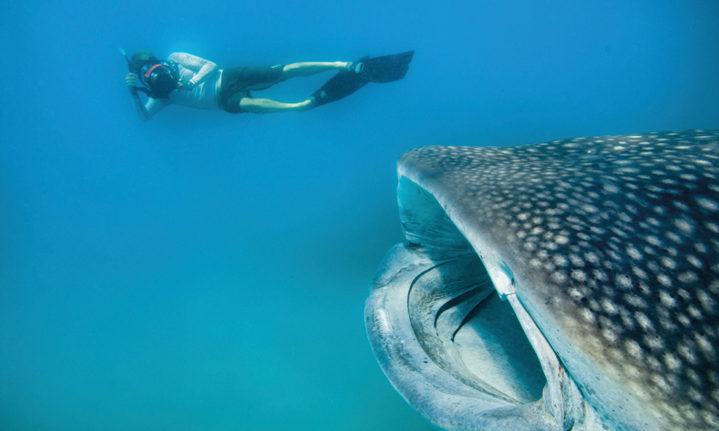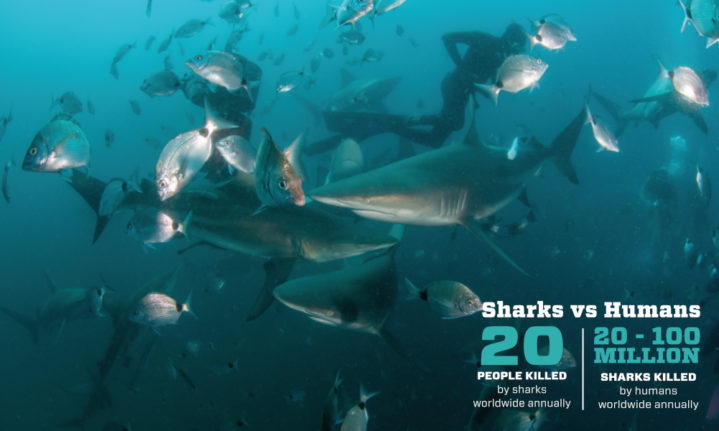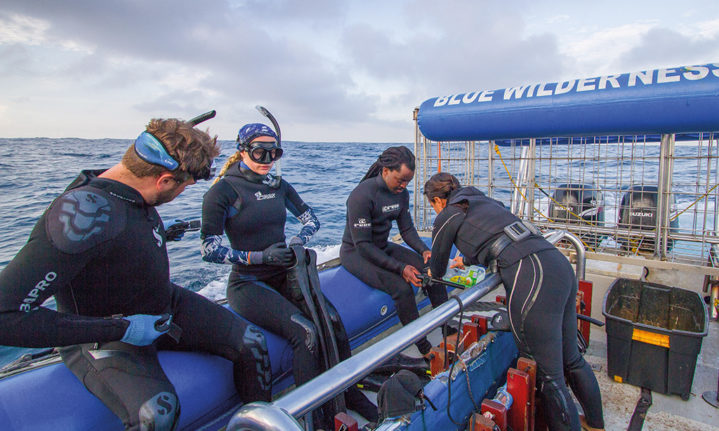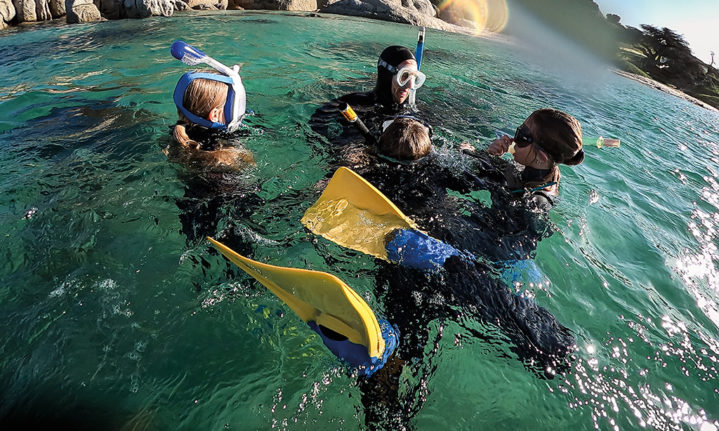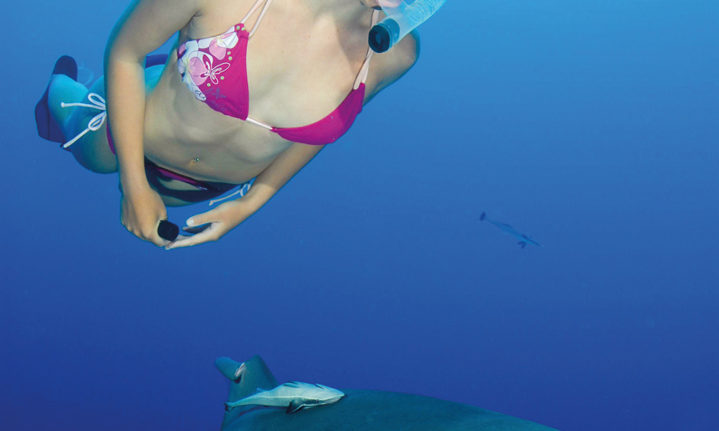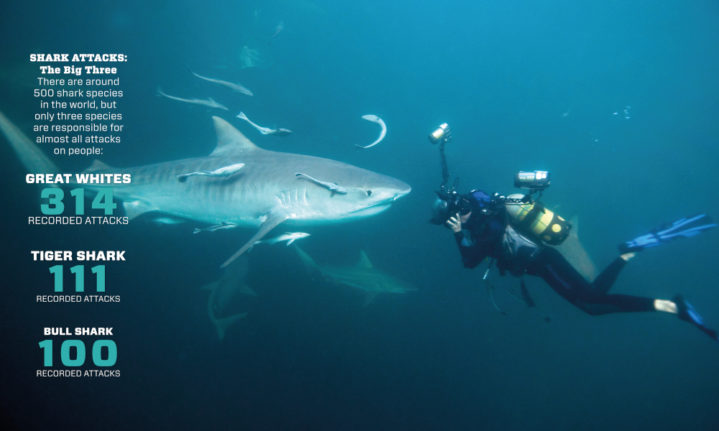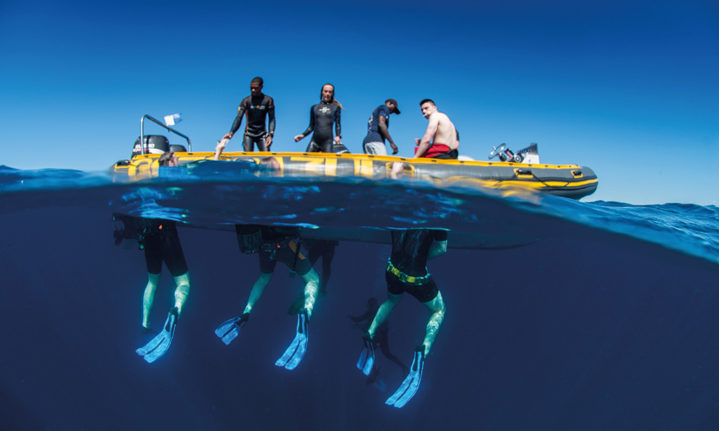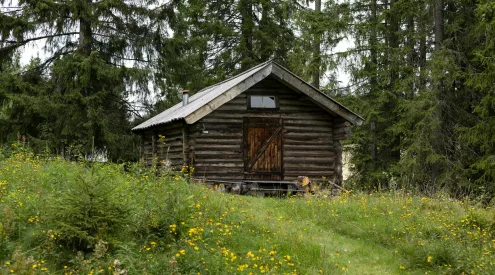Sharks inspire two things in humans: fear and fascination. Underwater photographer FIONA AYERST, who’s spent 25 years diving with sharks around the world, shares her favourite places in Southern Africa to get personal with these predators.
Words & Photos Fiona Ayerst
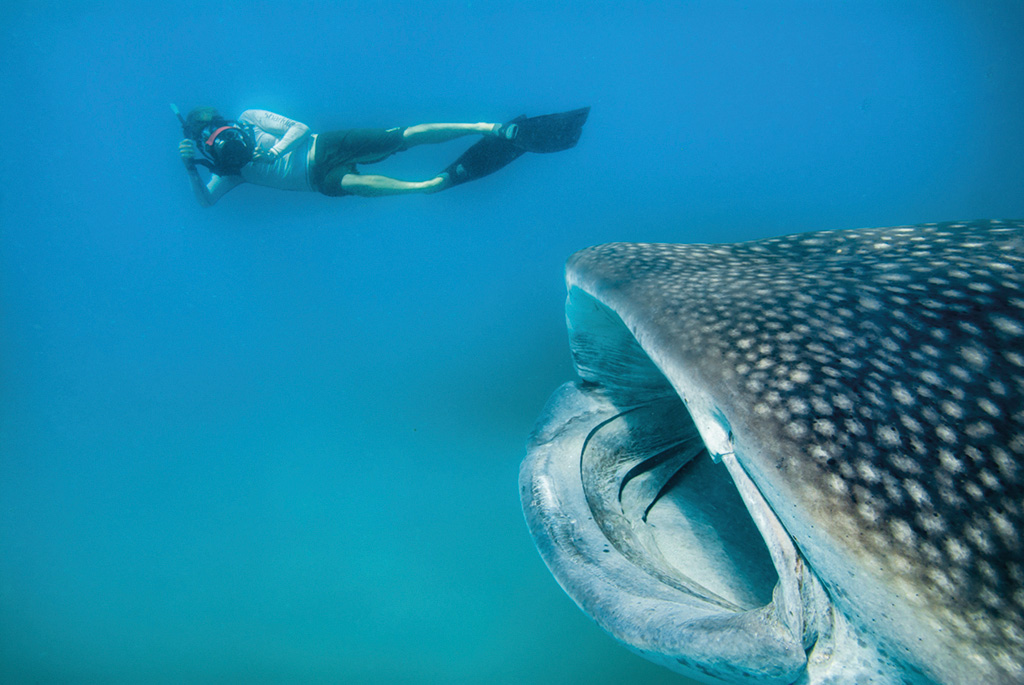
A fast-finning free diver captures a gentle giant on film – a filter-feeding whale shark oblivious to all except the krill.
Aliwal Shoal, KwaZulu-Natal With tigers, Raggies and more
My friends think I’m crazy when I tell them the only way to swim with sharks is to ignore them. But I know what a thrill it is to interact with this super-predator, arguably the most charismatic of the ocean dwellers. My favourite character is the tiger. Like massive boisterous puppies, they blunder into any situation – either fearless or carefree. They love electronic equipment, and I’ve sometimes seen cameras carried off in the jaws of happy sharks.
Apart from their blind hunger for scraps and carrion, tiger sharks are gorgeous striped creatures. As they swim past you with a gape-like grin, you can get lost in the black pools of their eyes. Don’t be too indifferent when diving with tiger sharks, though. They feed on carrion and clean up the oceans, so if you play dead, they may decide to do a bit of housekeeping. It’s a delicate balance!
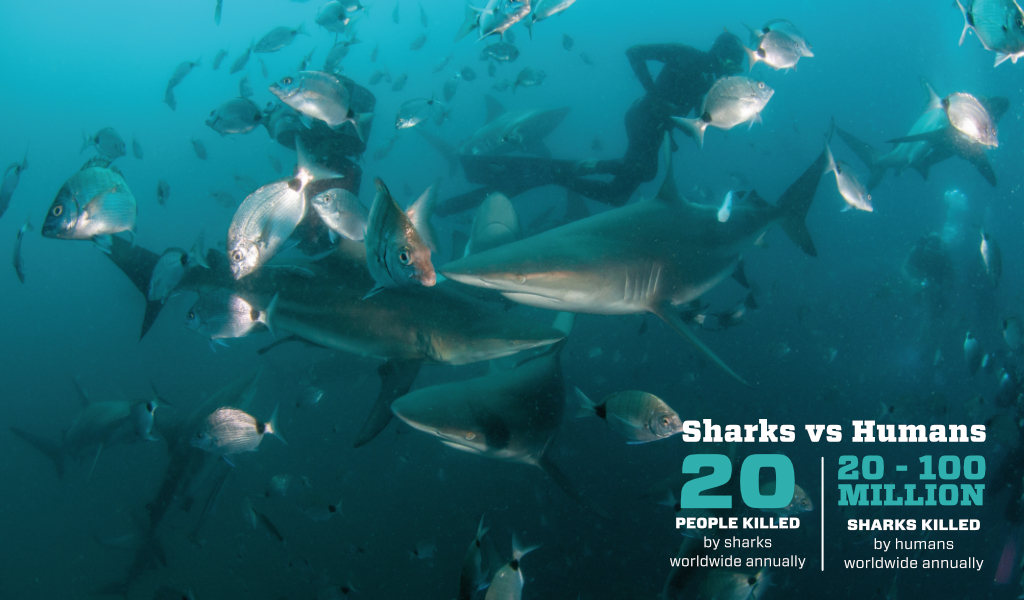
Snorkelling with black tips has become a mutually beneficial and popular tourist attraction.
Scuba divers shouldn’t miss out on a ragged-tooth shark dive. Raggies have been dubbed ‘tadpoles-with-teeth’ for their laid-back attitudes. In recent years raggies are spending more time on Aliwal Shoal, in large numbers, all year round. There are two raggie hotspots – Raggie Cave and the deeper Cathedral for more advanced divers. In the Cathedral structure you might encounter upwards of 40 sharks waiting for hunting hour. Good incentive to be out of there by 5pm!
Dive In
Generally, tigers love to feed and travel close to the surface, making for effortless viewing and snorkelling. The tiger interaction at Aliwal Shoal is best from March to May. If you don’t see tigers, you’ll still have the pleasure of diving with black tips or raggies. Snorkelling costs R1 100pp with gear included. Scuba dives are from R450pp (own equipment). 071 705 8518, or book online bluewilderness.co.za
Snorkelling with black tips
Catherine Hofmeyr
I’ve spent most of my ocean-going life trying to avoid sharks, and have so far, been mostly successful. Not so for Columbian marine biologist Dr Jess Escobar who, for the past several years, has been diving with sharks on Aliwal Shoal almost daily while researching her PhD thesis. Did I want to join Jess and her team for a snorkel one morning? Well, yes and no, but after some consideration… it was a yes.
Next morning I was at the Blue Wilderness premises in Scottburgh soon after sunrise. After getting our kit together, myself and a first-timer were briefed. We’d mostly be encountering ‘friendly’ black-tip sharks. ‘But if we see a tiger shark, I’ll call you together to stay on the pole,’ our dive master instructed us.

Dropping off a rubber duck into the frenzied world of feeding sharks on the Aliwal Shoal.
Five kilometres out to sea, the crew deployed a safety pole, floating between two buoys that we could hold onto to get acclimatised. ‘Slide in quietly, so that you don’t frighten them,’ Jess instructed as I prepared my mask and fins. Mnnn, not so sure it was the sharks who were frightened as I lowered myself into a sea of black tips. A fin brushed my arm. Black tips only eat small things, I remembered from the briefing. Gradually I relaxed into this experience of a lifetime, an hour spent snorkelling among Jess’ regular “girls”: Lady Grey, Smiley, Stacy and other gentle black tips.
Dive In
No prior diving experience is needed for this roughly three-hour adventure with Blue Wilderness.
Protea Banks, Kwazulu- Natal
With tigers, bulls and hammerheads
The Protea Banks, about seven kilometres off Margate on the KZN South Coast, is not for the faint-hearted. It’s a wild place; a heart-stopping launch through a narrow channel with whipping waves, a long boat ride and a deep dive (27–40 metres) that’s often into pea-green water with a pulsing current.
With bravery comes great reward, and when Protea Banks delivers, it does so in spades. I’ve seen schools of a thousand hammerhead sharks, massive submarine bull sharks with their tiny yellow piggy-eyes, and tiger sharks pushing each other around.

Tiger sharks are fearless scavengers, cleaning up the oceans.
The banks are made of a sea-mount that attracts pelagic fish and in turn the sharks that hunt them. On my 50-odd dives here, they’ve never failed to thrill. It’s a dive site like no other, but only for advanced divers.
Dive In
African Dive Adventures offers dives from R650 pp (with own equipment); baited dives cost R1 850 pp. They also have accommodation. 082 456 7885, afridive.com
False Bay, Western Cape
With blues and makos
If you’re ready to make a full day of it, and venture 30 kilometres off-shore, then snorkelling or diving with blue and mako sharks off Cape Town’s tip, is an excursion not to be missed.
I joined Shark Explorers for the experience, and was cursing the 5 am wake-up call, until we rounded Cape Point as the fiery sun slipped above the horizon, and my spirits lifted. The team dropped a drum filled with fish heads into the water, and the first shark arrived shortly after. I was hoping it was a blue. This species is playful and fearless around humans, and they love to bump into you, pushing with their pointy snouts. It’s easier to ‘cut your teeth’ on the blues, as you prepare for their more edgy cousin, the mako.
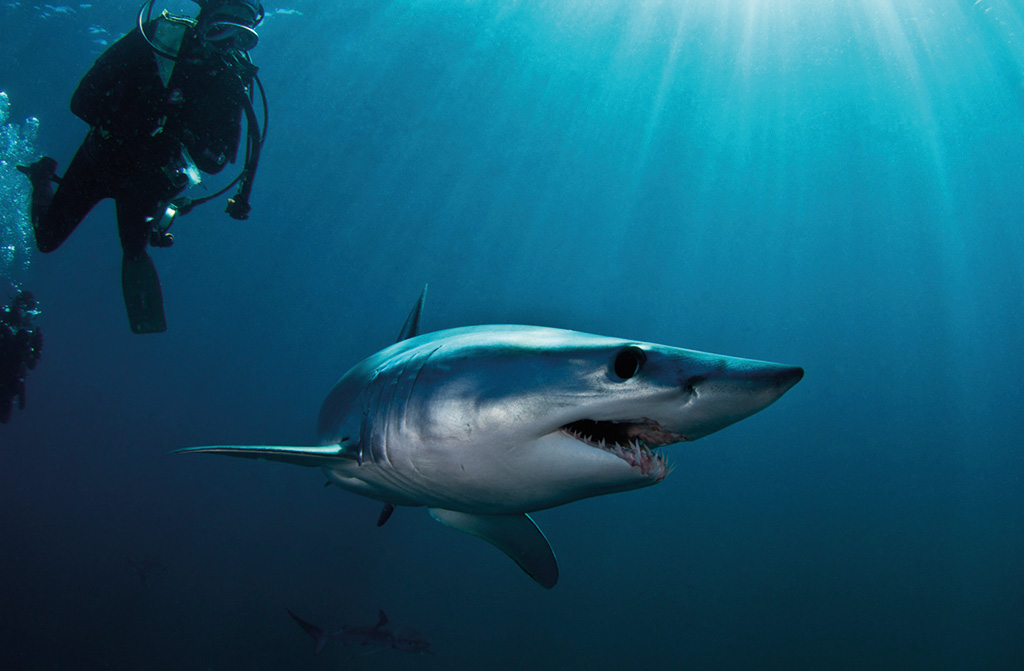
The bullet-like mako swims aggressively and has an impressive set of chompers.
On the periphery, a dark shape flickered, circling and watching us. A substantial female mako was sussing us out while swimming in circles around us, fast. Seemingly nervous, mako sharks look like torpedoes with a lot of teeth – silver bullets of sharky-flesh as they dart around unnervingly.
Dive In
The full-day trip costs R2 400 pp for snorkeling; from R3 000 pp for scuba diving. The season runs from October to July annually. 082 564 1904, sharkexplorers.com
In search of baby shark
Jaques marais
The first time you snorkel above a cold-water kelp forest, chances are good you’ll hyperventilate.
This involuntary reaction to cold water dilutes over many years of ocean play, but there’ll always be a little buzz of exhilaration as you fin out into False Bay – particularly if you’re following in the wake of Mike Barron from Cape Radd, in search of some sharks.
The sharks in question are not the ferocious kind. In fact, if you were to bump into indigenous cuties like the pyjama-shark, shy-shark or cat-shark they would have more reason to be scared of you.
This is exactly what you will learn if you join Cape Radd on one of their Citizen Science sessions. It’s a shore entry snorkel suited to beginners, so I took my kids Robert and Grace along for the adventure, and met Mike on Windmill Beach in the ‘outdoor classroom’.

There’s perfect snorkelling viz and friendly sharks off Simonstown (Photo Jacques Marais).
Approximately 30 min of instruction on species recognition and identification followed, before we headed into the crescent bay to explore the diverse kelp forests blossoming off Simonstown.
Our first significant encounter was not with a shark, but an octopus, perfectly camouflaged in a narrow rock crevasse. Thousands of sea urchins, periwinkles, soft corals and kelp fronds add flashes of colour, turning the ocean depths into an underwater wonderland. Shafts of sunlight beam through the gentle sway of giant kelp fronds, with dozens of different species of fish flitting about.
It took a while to locate the striped pyjama cat-sharks; three of them were languidly undulating along the seafloor, all looking harmless and prehistoric. These cartilaginous creatures grow to about a metre and generally feed on small reef fish and octopus.
If you’re really fortunate, you may see puff adder shy-sharks, cat-sharks or the splendid, spotted seven-gill cow-shark. The latter species grows up to three metres long, and 180 kilograms – reason enough to join a Cape Radd adventure.
Dive In
Open to over 12s with basic snorkelling skills. In doing the Citizen Science snorkel you’ll contribute to a good cause. Snorkelling from R600 pp for 2-3 hours, all gear supplied; scuba costs R1 400 pp. caperadd.com
The Pinnacles, Ponta Do Ouro, Southern Mozambique
With all the toothy fellas
This is well within my Top 10 shark dives in the world. Many South African divers don’t realise what we have on our doorstep.
The Pinnacles rise to about 30 metres and drop down dramatically on the sea-mount, so it’s a deep scuba only dive. 30-40 metre visibility into cobalt blue waters makes it a “sure thing” when many other shark dives can leave you “high-and-dry” due to unsatisfactory conditions.
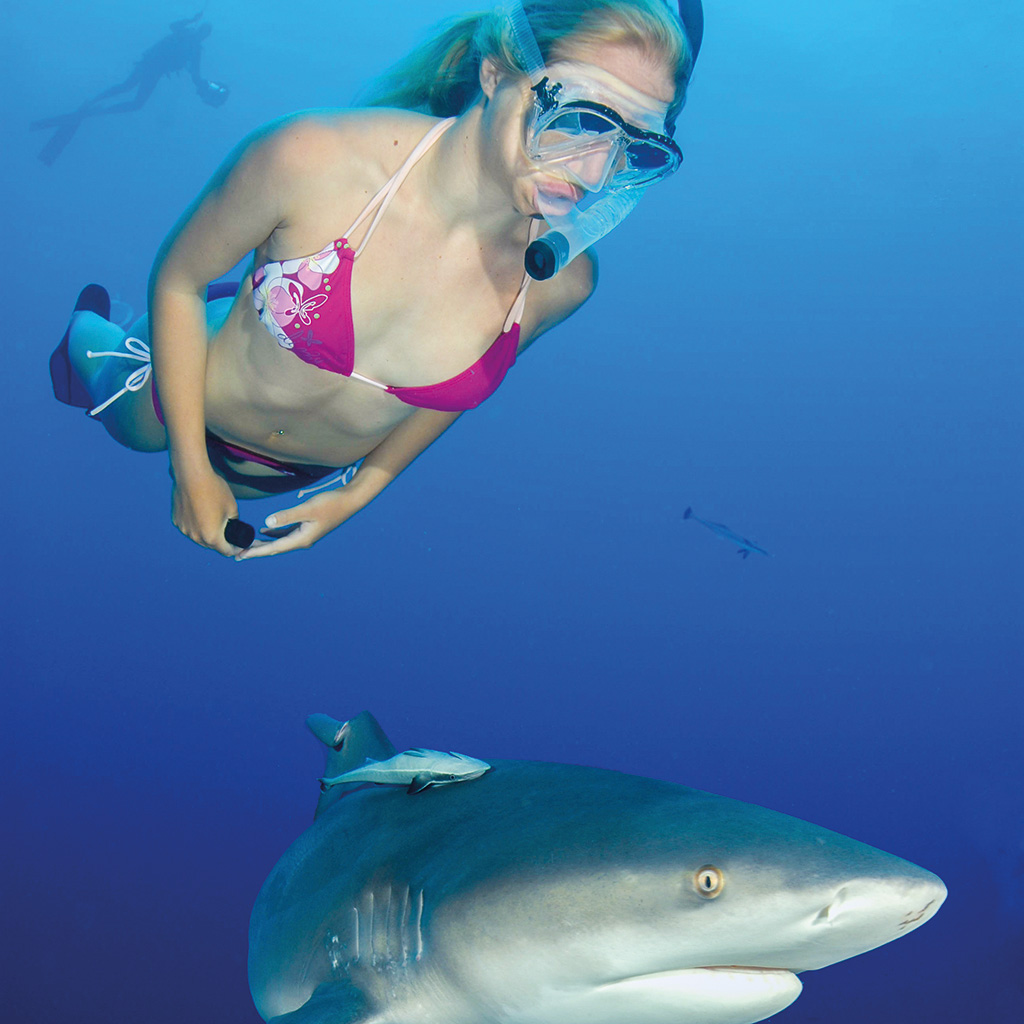
Media has evolved from portraying sharks with gaping, teeth-filled mouths instilling fear, to awe-inspiring scenes, showing what it’s actually like to swim with sharks – in this case a bull shark at Pinnacles.
Up to 14 different species of sharks have been recorded here, coming in search of pelagic fish. I’ve seen aggregations of bull sharks, sometimes up to seven on one dive. Tiger sharks are plentiful, and white-tips are common, as are schools of hammerheads.
Lucky divers have encountered great white sharks here more regularly than other dive sites in the area and there’s a good chance of seeing schooling kingfish and a battery of barracuda.

Fiona at work with her favourite shark, the inimitible tiger (photo Parvin Dabas).
Dive In
Pinnacles dive R600 pp; five-dive package, with gear R2 150 pp; ocean safaris with snorkelling from R480. +258 844 516 110, [email protected]
Just chill, bru
The best way to interact with sharks is to give them the cold shoulder. Sharks are apex predators. Humans are, too. When we meet in the ocean there’s an interaction, generally relating to positioning and eye contact. If you make a move towards a shark, it views you as a threat and will move away. It needs to protect all the precious sensory organs clustered around its face. It realises innately, that if you damage its face, it will be unable to feed and then die. Swimming towards the shark is enough to send it skedaddling. So, act casual when a shark passes by!
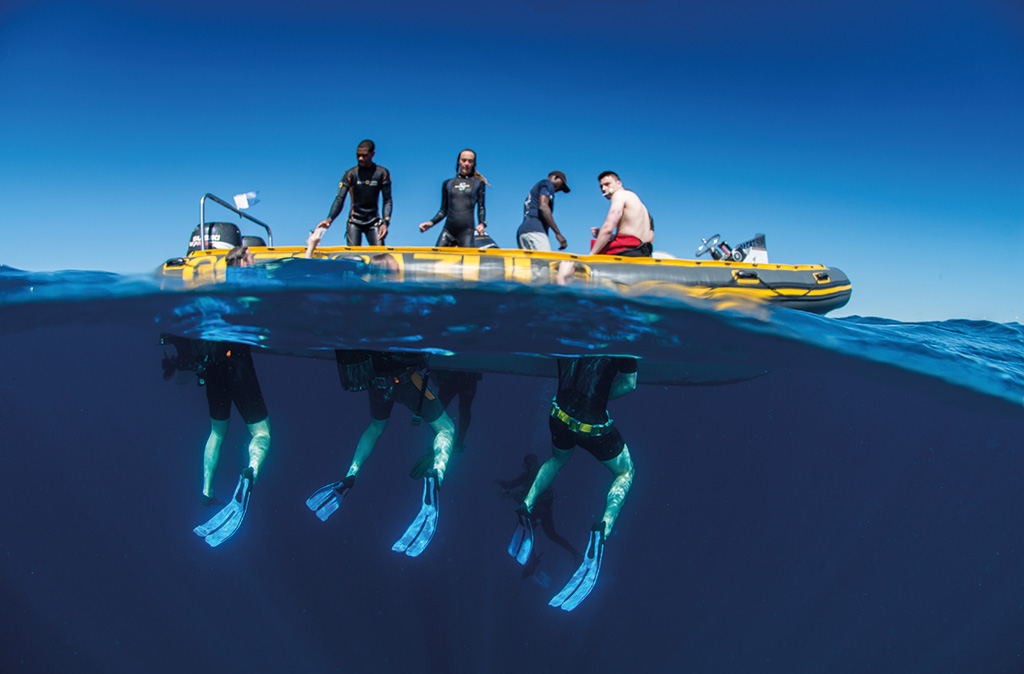
After diving almost any site in Mozambique, there’s still a chance to see dolphins or whale sharks on the boat trip home.
Tofo & Guinjata, Mozambique
With whale sharks
The entire stretch, between Tofo and Guinjata, is a pure delight for seeing whale sharks. The pre-valence of these mega fish here is due to plankton blooms which occur mainly between October and March. Also attracted by the bloom is another charismatic species – the manta ray. From around June to October, you’ll be sure to see humpback whales, too.
The whale shark is on many a bucket list, possibly because they don’t have teeth! And the best way to see them is on snorkelling trips. It’s surreal to jump into the water next to a 10-metre-long shark.
Impossibly beautiful, whale sharks are often accompanied by a flotilla of bright yellow pilot fish and remoras. On occasions, prodigal-sons (cobia fish) may also accompany them, and are often mistaken for baby whale sharks because they’re so large. Watching a whale shark approach is like watching an airbus in flight surrounded by small aircraft.
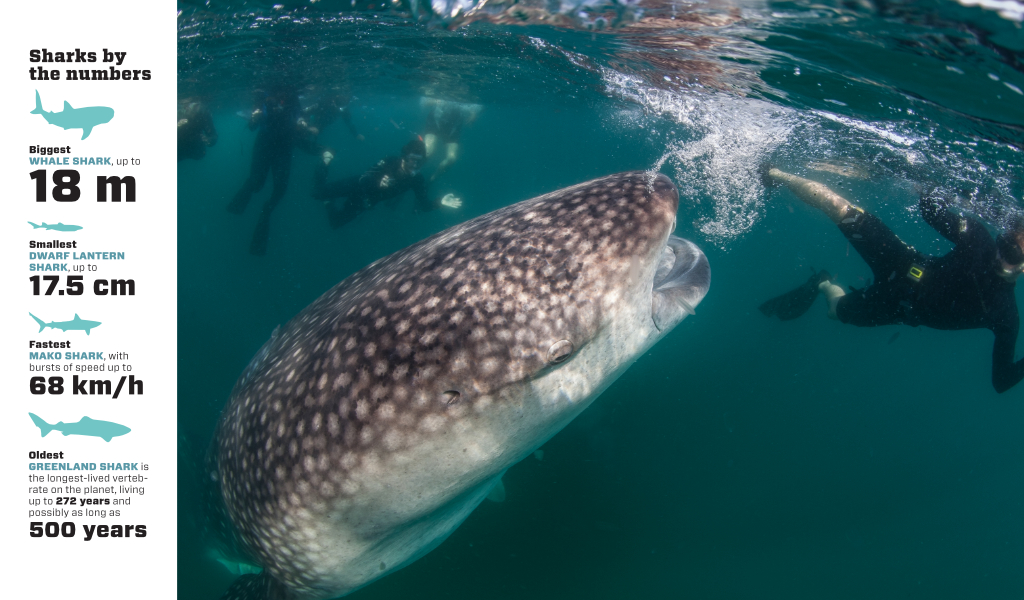
Whale sharks are gentle and shy by nature. When they’re feeding it’s the perfect time to observe them – but don’t touch.
Tofo and Tofino have had aggregations of up to 40 whale sharks, but mostly you’ll see three to four single sharks per outing.
Dive In
This snorkel is easy and fun with guides to help and teach you about shark con- servation. Ethical skippers will drop you about 50 metres in front of the shark to watch as it approaches. If the shark is relaxed and filter-feeding, it might hang about. Look around as you’ll often see five or more whale sharks, all feeding in a congregation. At Peri-Peri divers in Tofo The ocean safari costs R935 pp with equipment. Scuba dives from R600pp. +258 847 694 166, peri-peridivers.com
At Guinjata Bay I recommend Guinjata Dive Center. Prices vary according to dive sites but you’ll pay around 25 percent less than in Tofo. +258 844 015 449, diveguinjata.com









